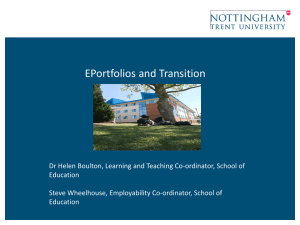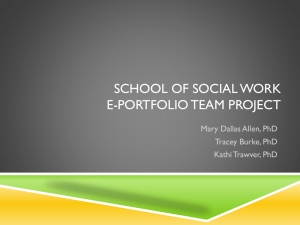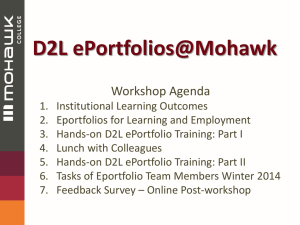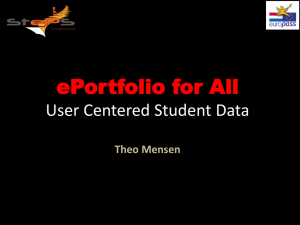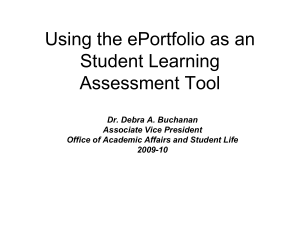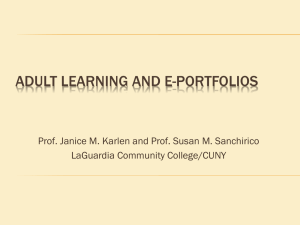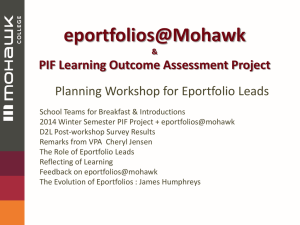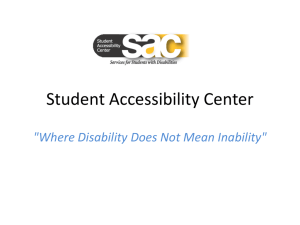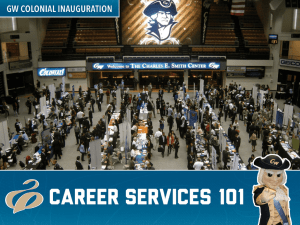Matt Russell Intro - University of Wisconsin System
advertisement
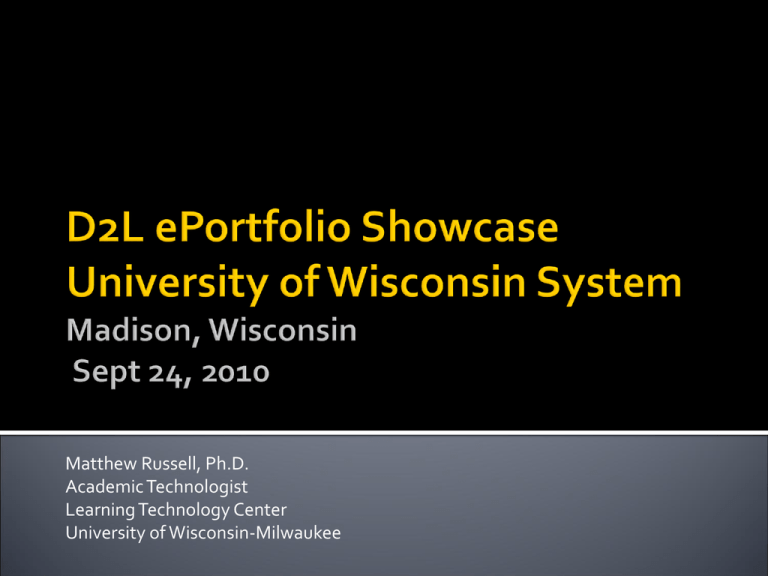
Matthew Russell, Ph.D. Academic Technologist Learning Technology Center University of Wisconsin-Milwaukee What are ePortfolios and how can they be used? What are the advantages of using Desire2Learn ePortfolios? Current Pilot Status Demonstration of ePortfolio software and use cases Evaluation of student and faculty use at UWM Next steps A digitized, portable collection of artifacts including demonstrations, resources, and accomplishments that represent an individual, group, or institution Can be comprised of text-based, graphic, or multimedia elements shared or presented on a Web site or on other electronic media Learning is an active process through which knowledge is constructed. It requires facts, context, practice, reflection, and constant effort. … Rather than focusing on that which is produced, an electronic portfolio demonstrates the process through which students learn. (EDUCAUSE NLII, New Learning Ecosystems: 2004 NLII Annual Review ) Desire2Learn CMS is used by UW system D2L ePortfolio tool chosen for pilot because of integration with D2L CMS and costs of adoption Seven UW System campuses in pilot At UWM, the ePortfolio tool is being piloted in a range of courses, program-level evaluation and adminstration, and a few non-academic programs Personal portfolios-- Designed for self-reflection, these kinds of portfolios can be used to journal experiences, organize materials from classes and activities, and help students recognize skills and make decisions. Learning portfolios– These can be used to showcase student learning, provide a framework for assessing academic progress, and demonstrate how skills have developed over time. Professional and co-curricular portfolios– These can be used to help make career decisions, demonstrate that one has met program or certification requirements, present skills and accomplishments for employment, and review professional development for career advancement. Course-specific projects Face-to-face, blended, online Entry into graduate programs (Graphic Design) Meeting certificate program or professional outcomes (Education, Nursing, Business Nonprofit program) Field trips/research ePortfolio use is aligned with teaching and learning goals that emphasize student self-reflective growth Build on existing support structures within UWM and UW system Peer development: Showcase professional development uses of student ePortfolios among students D2L ePortfolio is familiar to D2L users and applicable for many different kinds of student/instructor interactions within the CMS Makes student work visible to university and community at large Use ePortfolios to legitimate the academic rigor of blended and online classes Course design or re-design must focus on the creation of meaningful ePortfolio activity by students ePortfolio pieces must be a part of a coherent whole product that is assessed in process and rooted in learning objectives for course or criteria for professional programs Short reflective prompts and multimodal writing assignments must accompany ePortfolio activities at every stage Low stakes, frequent building of ePortfolio that is given student- and instructor-based feedback and assessed often Rubrics (that also accounts for ePortfolio design) must be used to assess ePortfolio work Students must be required to showcase ePortfolio work for class or program and be rewarded for it One-stop shopping and single sign-on Familiar interface and support structures already in place No additional up-front fees Able to easily create web sites that can be shared outside university community Able to easily integrate multimedia or other creative technologies into course work or professional portfolios Able to bring together academic work and co-curricular activities Develop a sense of ownership over the learning process Present an expanded, multimedia resume that can be disseminated widely and quickly to multiple audiences via the Web or networking tools Present the applicant’s goals, accomplishments, skills, and knowledge to prospective employers before an interview Provide examples of projects completed in classes as well as in the work environment or through volunteer and co-curricular experiences Allows for the integration of student reflection on personal or professional growth with academic achievements Can be integrated into program-level assessment via collections of student work Proficiency of written and oral communication skills can be demonstrated through samples in the ePortfolio Documentation of technology-based, leadership and interpersonal skills as exhibited in team projects presented in the e-portfolio Demonstrate mastery of specific knowledge and skills required by licensure and certification boards Student Examples of Work Sharing Satisfaction Feedback Manage 70 60 50 40 30 20 10 0 The ePortfolio helped me successfully share my work with others. I liked being able to share my presentations. Sharing my presentations was useful. 70 60 50 40 30 20 10 0 The ePortfolio allowed me to receive comments from others. Sharing my presentations allowed me to receive feedback on my work. The feedback I received on my presentations was useful. 70 60 40 The ePortfolio successfully stored the artifacts I created. 30 The ePortfolio helped me organize my work. 50 20 10 0 I liked that I was able to control how my presentation looked. 70 60 50 40 30 20 Accessing the ePortfolio was easy Overall, I am happy with using the ePortfolio 10 0 I would take another course that used the ePortfolio “It looked more professional. I could do it at home at any time of the day/night. I could leisurely look at others' work and learn from it. “It was easily accessible since it is on the internet and not a computer program, confined to one computer.” “The ability to pick and choose what you wanted to learn and share that information.” “It was easy to express your own personal interests.” “I liked the creative aspect of using ePortfolio. It was fun to create the visual displays.” “The ePortfolio assisted students to highlight their major accomplishments and reflect on their overall learning and growth in the program.” “Students were able to learn from classmates' projects and improve their own. I think I could have done more with that.” “(It) was a great way to facilitate presenting a final portfolio for program outcomes.” “The ePortfolio has been used in the last semester of the program so it was a way to summarize learning and accomplish program review. By introducing ePortfolio earlier, it could potentially impact performance by encouraging students to evaluate their learning and plan activities to address areas needing improvement.” ePortfolio Upgrades and Fixes: Development of tool by D2L by Spring 2011 Exportable ePortfolio (.pdf and .html versions) Ease of Use / User Interface Scalability: Develop Efficient Models of ePortfolio Support for Expanded Academic and Program-required Uses Expansive Goals: Aligning and Generating Data from ePortfolio use with UWM and UW System Agenda Items Student Recognition: Make ePortfolio Work Visible and Legitimate for Multiple Audiences (Student Showcasing) Co-curricular and Professional Development Uses: Continued demonstration of expanded usability of tool for students and faculty Outreach to Student Services: Outreach to campus groups, tutoring and peer mentoring, and the IT help desk Questions / Comments? Contact Information: Matthew Russell, Ph.D. Learning Technology Center University of Wisconsin-Milwaukee russelmr@uwm.edu UWM ePortfolio Pilot web site: http://uwmeportfolios.wikispaces.com/
